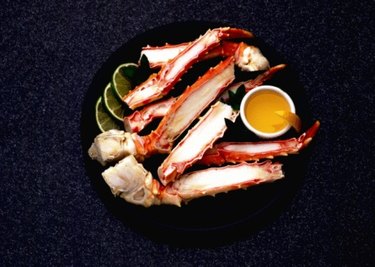
The process of eating crab legs is more than a meal, it's an experience. Though crab legs contain wonderfully textured, delicate meat that tastes sweet and succulent, getting to the heart of the matter takes a little work. Eating crab legs requires a some vigor from the diner, as well as a small array of table tools and accessories. Be sure to lay out the proper tools when serving crab legs to friends and family at home.
Serving Tools
Video of the Day
You'll need a container from which to serve crab legs at a table setting. As crabs are often boiled, cooks can serve crab legs from the pot in which they were cooked. You can also use a large bowl, such as a salad bowl, or simply place a pile of crab legs on a roomy tray or platter. Place a pot holder or trivet under the serving dish if placing a hot piece of cookware on the table.
Video of the Day
Tableware
Crab legs, especially of the king crab variety, take up a lot of space, so a large plate comes in handy. Etiquette dictates that diners should place inedible parts of the crab legs on the side of their plates, but you can also serve crab with a main plate and a smaller side dish or bowl for waste. You can place garnish, such as lemon slices, on the main plate or additional side plates. Serve crab with a small dish or sauce bowl to hold hot melted butter, garlic butter or cocktail sauce.
Utensils
Proper cracking utensils are perhaps the most essential tool for eating crab legs. Diners commonly use a nut cracker to make the initial break, though crab scissors can easily cut through the inside of the leg. You can use a small hammer or mallet to crack the large claws, where the most succulent meat is found. Though many diners simply suck the meat out of the cracked shell, seafood picks or appetizer forks help make dining on crab legs a neater process. Full-sized forks and knives also help diners remove meat from the interior walls of cracked crab legs.
Accessories
Plenty of napkins, whether cloth or paper, are vital accessories as crab legs are hands-on food and cause greasy fingers. Wet naps certainly come in handy. Bibs, disposable or washable, help protect nice clothes from any stray juices. Put down a newspaper or tablecloth to make cleanup an easier process. Store leftovers in airtight containers, plastic wrap or lightweight foil.